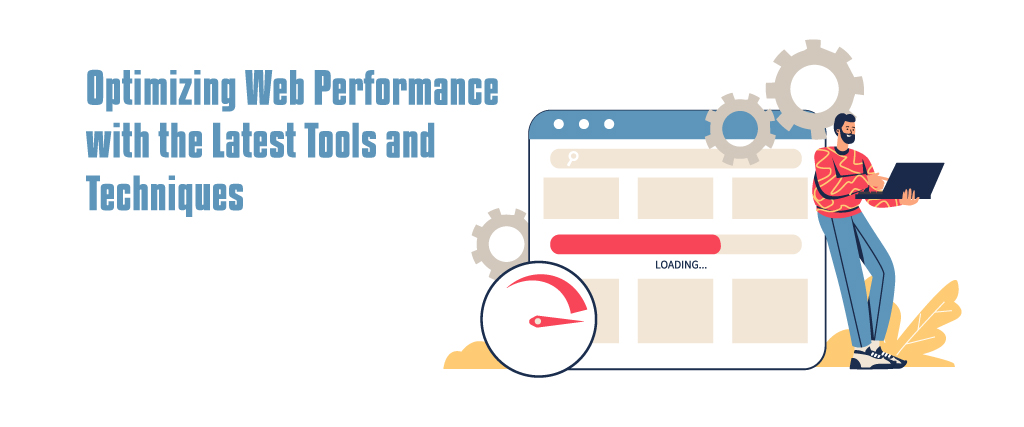Optimizing Web Performance with the Latest Tools and Techniques

In the digital age, where users expect instant access to information and seamless browsing experiences, web performance optimization has become critical for website owners and developers. The result of a slow-loading website is frustrated users, increased bounce rates, and ultimately, lost business opportunities. To address these challenges, web developers are constantly seeking ways to optimize web performance through the utilization of cutting-edge tools and techniques.
What is meant by Web performance optimization?
Web performance optimization refers to the practice of improving a website's speed, responsiveness, and overall performance to enhance user experience and achieve business goals. It involves various techniques and strategies aimed at reducing page load times, minimizing server requests, and optimizing resource delivery. Efficient web performance optimization starts with optimizing code, using minification and compression to reduce file sizes. Caching mechanisms are employed to store frequently accessed data, reducing server load and speeding up subsequent visits. Content Delivery Networks (CDNs) are utilized to distribute content geographically, reducing latency. Image and media optimization are crucial for faster loading times, while lazy loading delays non-essential content until it's needed. Mobile responsiveness is prioritized, considering the growing number of mobile users. Monitoring and continuous improvement are essential, as technologies evolve, and user expectations increase. Regularly analyzing site performance, identifying bottlenecks, and implementing best practices ensure a smooth and seamless user experience, positively impacting visitor retention and conversion rates.
Why do we optimize website performance?
Optimizing website performance is crucial for several compelling reasons. Firstly, a fast-loading website enhances user experience, leading to higher engagement and reduced bounce rates. Users are more likely to stay and explore a site that loads quickly, improving overall satisfaction and encouraging repeat visits. Secondly, search engines, like Google, prioritize fast-loading websites in their rankings. Improved performance positively impacts SEO, boosting visibility and organic traffic. Thirdly, optimized performance reduces server load and bandwidth usage, translating into cost savings for website owners. Moreover, in the mobile-dominated era, performance optimization becomes even more critical, as users expect smooth experiences across various devices. Ultimately, prioritizing website performance is a key component of creating a successful online presence, benefiting both users and website owners alike. In this article, we will explore some of the latest approaches and tools that can be employed to enhance web performance, resulting in faster loading times and a more satisfying user experience.
Embracing Progressive Web Apps (PWAs):
In recent years, progressive web apps have gained popularity due to their ability to deliver an app-like experience directly through the web browser. By leveraging service workers and caching, PWAs can significantly reduce loading times, even in low or unreliable network conditions. Users can access PWAs instantly without the need to download them from an android app store, leading to higher user engagement and retention rates.
Leveraging Content Delivery Networks (CDNs):
Content Delivery Networks have long been a staple for optimizing web performance. CDNs store website assets, such as images, JavaScript, and CSS files, on multiple servers distributed across various geographic locations. This enables users to download these assets from a server that is physically closer to them, reducing latency and accelerating page load times.
Image Compression and Lazy Loading:
Images are often the largest files on a web page, contributing significantly to longer loading times. By compressing images without compromising quality and implementing lazy loading, where images are loaded only when they come into the user's viewport, web developers can save bandwidth and expedite page rendering.
Minifying and Bundling JavaScript and CSS:
Minifying and bundling JavaScript and CSS files involve removing unnecessary characters, whitespace, and comments from code, thus reducing file sizes. Smaller files load faster, resulting in improved web performance. Additionally, bundling multiple files into one minimizes the number of HTTP requests, further enhancing load times.
HTTP/2 and HTTP/3 Protocols:
Upgrading to the latest HTTP protocols, such as HTTP/2 and HTTP/3, can significantly improve web performance. These protocols introduce features like multiplexing, server push, and reduced connection setup times, resulting in faster loading of assets and improved overall performance.
Utilizing Browser Caching:
Browser caching enables a web page to store certain files on a user's device temporarily. When the user revisits the page, the browser can fetch cached files locally instead of downloading them again from the server. This caching strategy reduces server load and speeds up subsequent page visits.
Asynchronous Loading of JavaScript:
By loading non-essential JavaScript files asynchronously, web developers can ensure that critical content is displayed to users without waiting for less important scripts to load. Asynchronous loading prevents JavaScript from blocking the rendering of a page, leading to a faster initial page load.
Prefetching and Preloading:
Prefetching and preloading are techniques that anticipate the user's actions and fetch resources in advance. Prefetching downloads resources that are likely to be needed on the next page, while preloading fetches resources required for the current page. These strategies reduce perceived loading times and enhance user experience.
Server-Side Rendering (SSR) and Static Site Generation (SSG):
Server-Side Rendering and Static Site Generation move some of the page rendering processes from the client-side to the server-side, resulting in faster page loads and improved SEO. SSR generates and sends the fully rendered page to the client, while SSG generates static HTML pages during the build process, eliminating the need for client-side rendering entirely.
Web Performance Monitoring and Optimization Tools:
A variety of web performance monitoring and optimization tools are available to assist developers in identifying bottlenecks and implementing improvements. Tools like Google PageSpeed Insights, Lighthouse, WebPageTest, and GTmetrix offer valuable insights and suggestions for enhancing web performance.
Conclusion
In conclusion, optimizing web performance is a continuous and ever-evolving process. Implementing the latest tools and techniques, such as Progressive Web Apps, Content Delivery Networks, image compression, HTTP/2, and Server-Side Rendering, can significantly improve website loading times and deliver an exceptional user experience. By staying abreast of emerging trends and embracing best practices, web developers can ensure that their websites remain competitive in the fast-paced digital landscape, keeping users engaged and satisfied.
